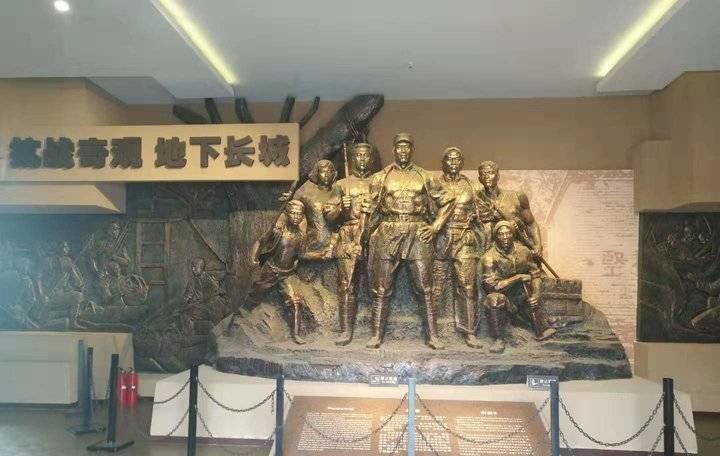
Walking into Ranzhuang, you can see not only the tunnels that once crisscrossed the Jidong Plain, but also a vivid mass line, connecting the vast ocean of people's war. The famous Ranzhuang Tunnel Battle is one of the waves that leaps and falls. On China's vast battlefield behind enemy lines, the Communists relied closely on the people and grew rapidly.
In October 1935, the Red Army arrived in northern Shaanxi and opened up a new base area in the far northwest, after which the Central Committee of the Communist Party of China convened the Wa Yao Fort Conference and proposed an anti-Japanese national united front; the following year, the Double Twelve Xi'an Incident broke out, which led to the second Kuomintang-Communist cooperation and temporarily suspended the Kuomintang-Communist civil war; only half a year later, the July 7 Incident broke out and the all-out War of Resistance began; three months later, in October 1938, the 115th Division of the Eighth Route Army jumped out of the enemy's rear and launched out to the Jin-Cha-Ji region.
In the strategic defensive stage in the early stage of the War of Resistance Against Japanese Aggression, the frontal battlefield of the Nationalist Government and its leadership quickly retreated from the eastern coast to the interior, and it is not difficult to imagine that the Hebei Plain, which is close to the occupied areas in the northeast, was the first to be the front. In traditional Chinese society, the masses are scattered and scattered, and once they are organized under the unity and leadership of the party, they are an invincible force. In the just struggle to defend the country and win liberation, the Hebei Plain, which was originally undefendable, staged a miracle of tunnel warfare.
The burning and plundering of the Wokou awakened the Chinese people and aroused the indestructible will to survive of the Chinese nation. After the Eighth Route Army advanced into Jin-Cha-Ji, The Wokou immediately drew out its troops and tried to nip the resistance behind the enemy lines in the bud. Faced with the situation in which the enemy is strong and we are weak, the Eighth Route Army carried out flexible guerrilla warfare in the vast rural areas in accordance with the operational thinking of "preserving strength and destroying the enemy." After several battles, the Wokou were unable to eliminate the soldiers and civilians behind the enemy lines, and could only shrink into the strongholds along the railway line, and the grand layout of the countryside encircling the city was gradually unfolding.
After the War of Resistance Against Japanese Aggression entered the stage of stalemate, wokou launched a "campaign to strengthen public order" in an attempt to concentrate forces on eliminating the war of resistance behind enemy lines and establishing a solid rear. Brutally sweeping up the so-called "non-public security areas," implementing the barbaric Sanguang policy and the "cage policy," and using the tactics of "combing grates vertically and horizontally and encircling with iron walls," a large number of roads, artillery towers, and blockade ditches were built in the vast theaters of operations, including the Jizhong Plain, in an attempt to finely cut them up and strangle the enemy's rear to resist the war.
In this context, starting from the "toad squatting" in the single-mouth cave where the masses evaded pursuit and killing, after countless bloody lessons, the tunnel warfare of the people in Jizhong gradually developed and matured, and excavated the underground Great Wall where every household is connected and the villages and villages are connected. The people of Ranzhuang alone built tunnels up to 32 miles long, fought 157 battles, and annihilated more than 2,100 enemies, showing the powerful power of the people's war. The invincible Wokou had to lament: "It is better to go around the mouth of the black wind than to go from Ran Zhuang." So far, walking into the ranzhuang tunnel war site, the ingenious and practical fortifications on the ground and underground are breathtaking, like a fortress for all the people.
The blade of the armed struggle, the thick back of the knife, comes from the mass line, and the united front plays an irreplaceable role. In view of the structure of Chinese society of "two small ends and large in the middle", "winning over the masses of the middle class and making them each have their own place according to the situation" has become an important basis for formulating the general policy of the anti-Japanese national united front. In the land policy that determines success or failure, the base areas have adopted a policy of combining rent reduction and interest reduction with rent payment, which has reconciled the relations between rural society and won the greatest common denominator. Facts have proved that wanting to be together and working together with the masses of the people has become the basis for the vigorous development of the political power in the base areas.
Looking back at history, "coming from the masses to the masses" and "letting go and mobilizing the masses" are the incomparable political advantages of the Chinese Communists, who took root in the vitality of the Party among the masses of the people in the War of Resistance Against Japan. (Hu Chunyu)